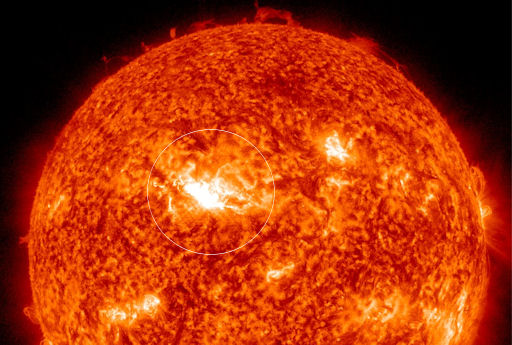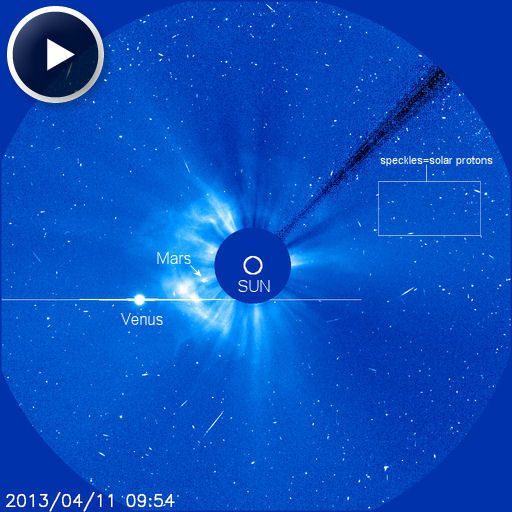INCREASING CHANCE OF FLARES: NOAA forecasters have raised the odds of an X-class solar flare today to 15%. The move was prompted by yesterday's almost-X flare (M6), which hurled a CME toward Earth. Earth-facing sunspot AR1719 would be the probable source of any eruptions. Solar flare alerts: text, voice.
STRONG SOLAR FLARE: The magnetic field of sunspot AR1719 erupted on April 11th at 0716 UT, producing an M6-class solar flare. NASA's Solar Dynamics Observatory recorded the explosion's extreme ultraviolet flash:
Shortly after the flare, a CME emerged from the blast site. NOAA forecasters estimate a 60% chance of geomagnetic storms on April 13th when the cloud reaches Earth. High-latitude sky watchers, be alert for auroras! Aurora alerts: text, voice.
Click to play a movie of the CME recorded by the Solar and Heliospheric Observatory:
The speckles near the end of the movie are caused by energetic solar protons hitting the coronagraph's CCD detector; the particles were accelerated in the direction of the spacecraft by the flare.
Note that although the CME appears to hit Mars and Venus, there is no actual physical contact. The cloud is merely passing in front of the two planets. Stay tuned for updates about this significant explosion.

![]()
Solar wind
speed: 426.5 km/sec
density: 1.7 protons/cm3
explanation | more data
Updated: Today at 1547 UT
![]()
X-ray Solar Flares
6-hr max: C1 1003 UT Apr12
24-hr: C2 0414 UT Apr12
explanation | more data
Updated: Today at: 1500 UT
![]()
![]()
![]()
Daily Sun: 12 Apr 13
![]()
![]()
Sunspot AR1719 has a delta-class magnetic field that harbors energy for X-class solar flares. Credit: SDO/HMI
![]()
![]()
![]()
Sunspot number: 121
What is the sunspot number?
Updated 12 Apr 2013
Spotless Days
Current Stretch: 0 days
2013 total: 0 days (0%)
2012 total: 0 days (0%)
2011 total: 2 days (<1%)
2010 total: 51 days (14%)
2009 total: 260 days (71%)
Since 2004: 821 days
Typical Solar Min: 486 days
Update 12 Apr 2013
The Radio Sun
10.7 cm flux: 137 sfu
explanation | more data
Updated 12 Apr 2013
![]()
![]()
![]()
Current Auroral Oval:
![]()
Switch to: Europe, USA, New Zealand, Antarctica
Credit: NOAA/POES
![]()
![]()
![]()
Planetary K-index
Now: Kp= 1 quiet
24-hr max: Kp= 2 quiet
explanation | more data
![]()
Interplanetary Mag. Field
Btotal: 5.0 nT
Bz: 1.5 nT north
explanation | more data
Updated: Today at 1547 UT
![]()
![]()
![]()
Coronal Holes: 12 Apr 13
![]()
![]()
There are no large coronal holes on the Earthside of the sun. Credit: SDO/AIA.






